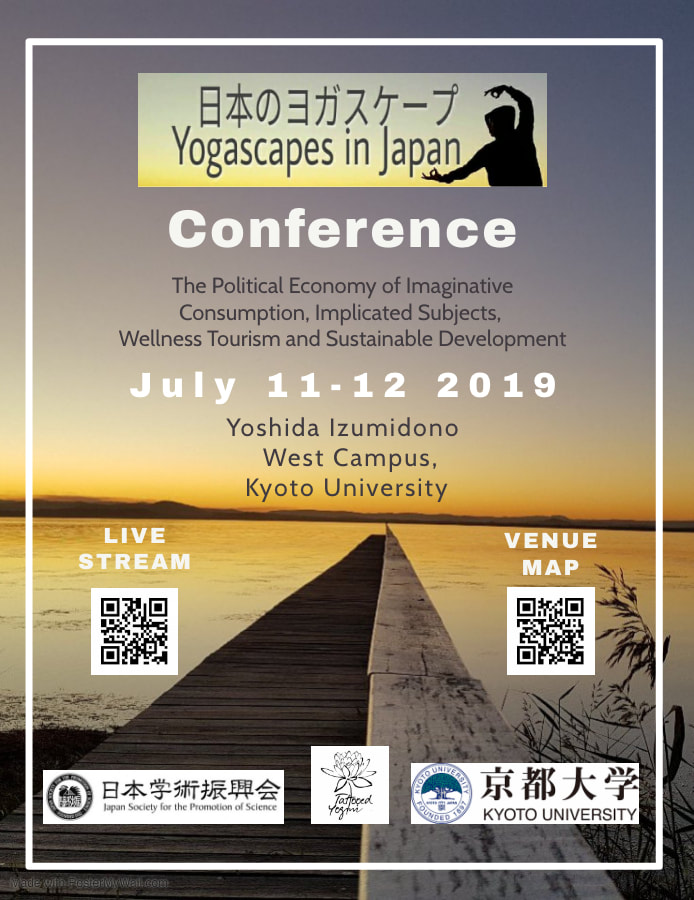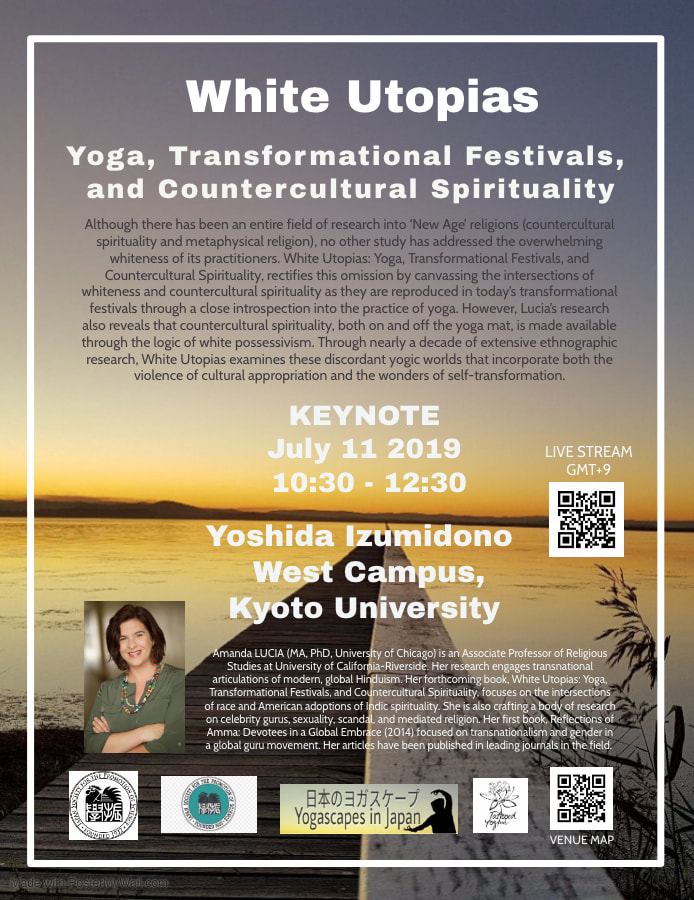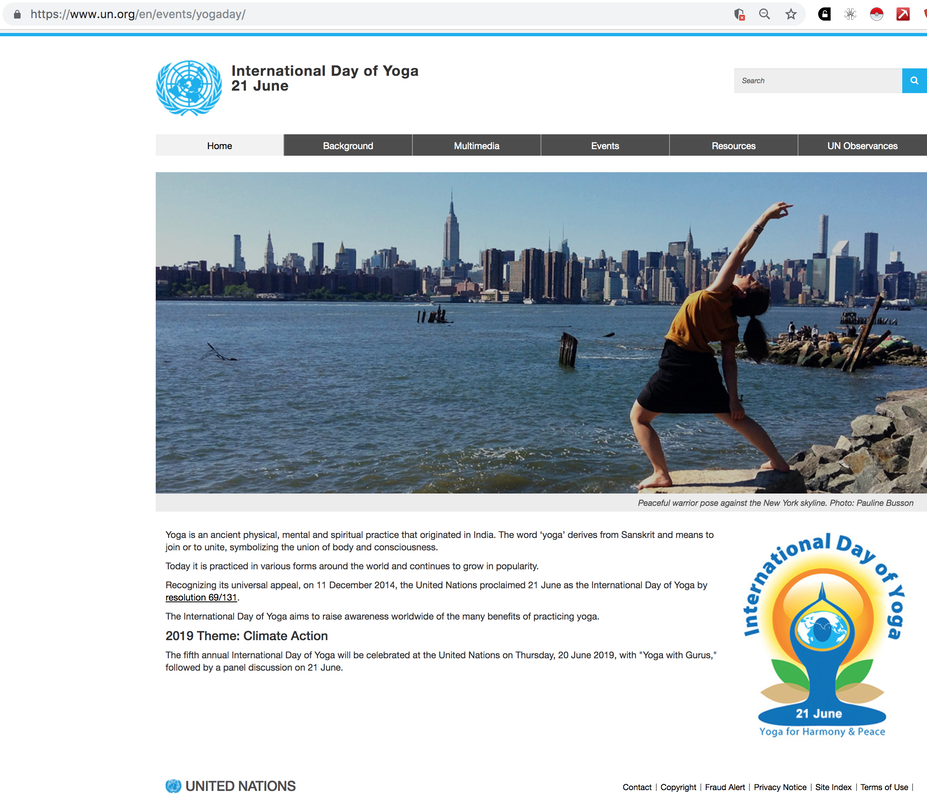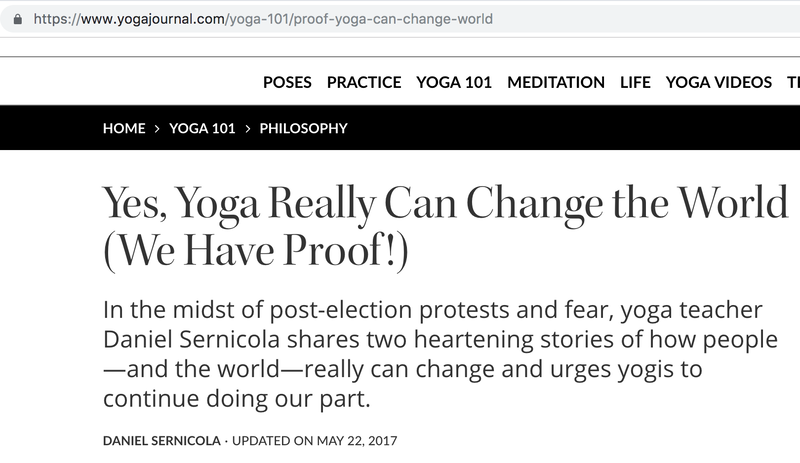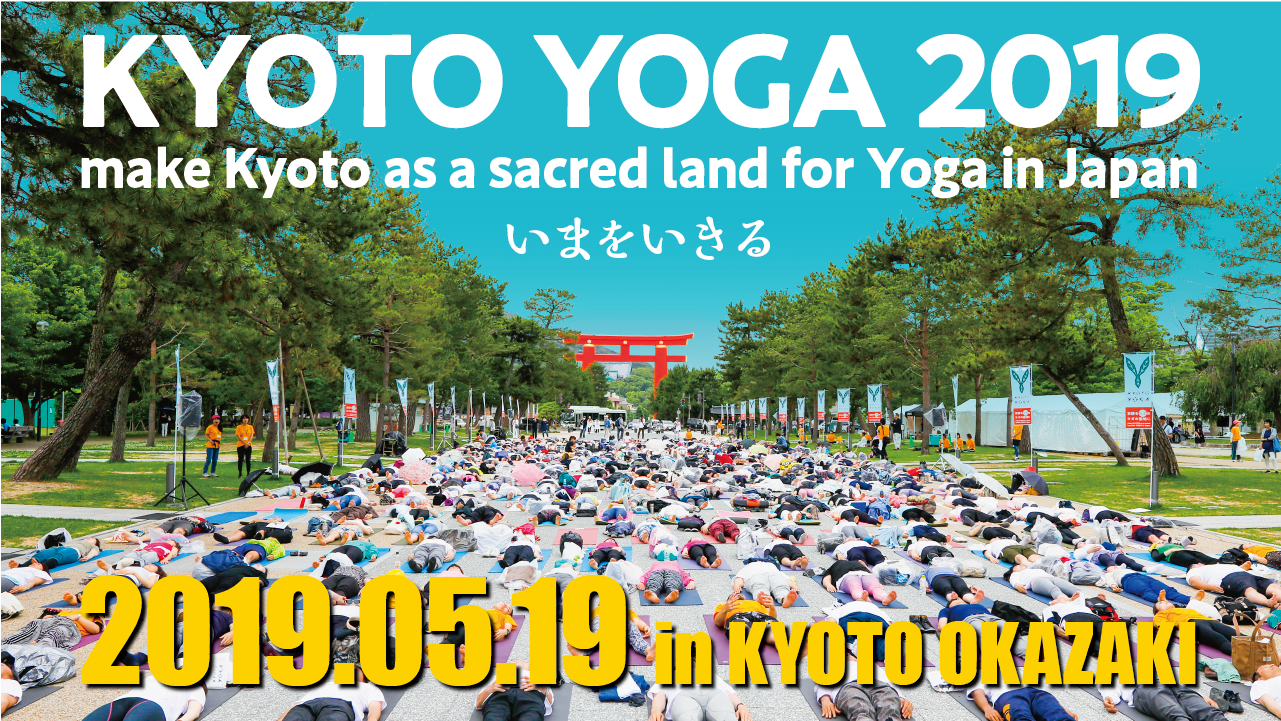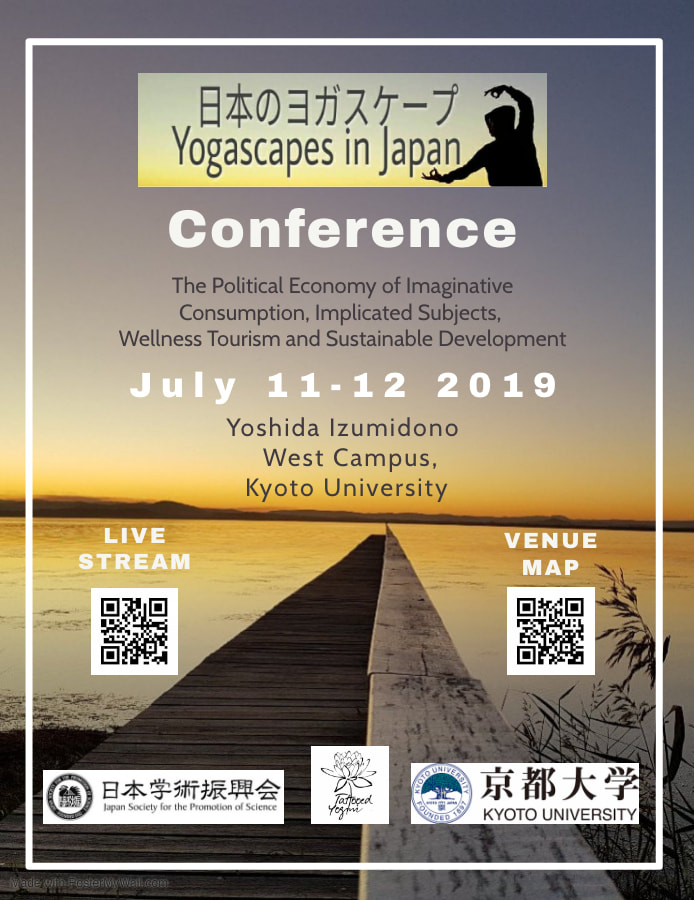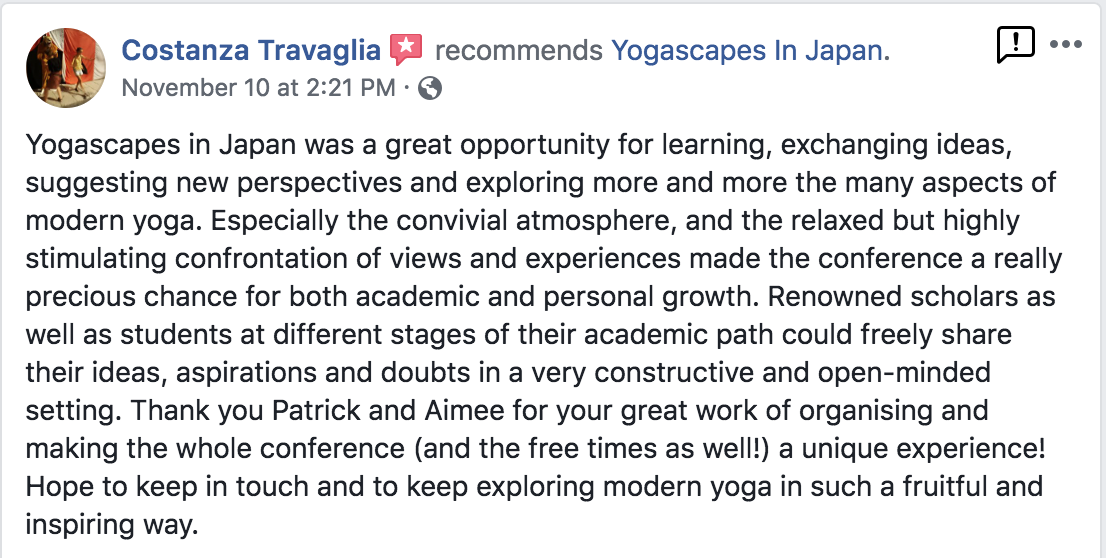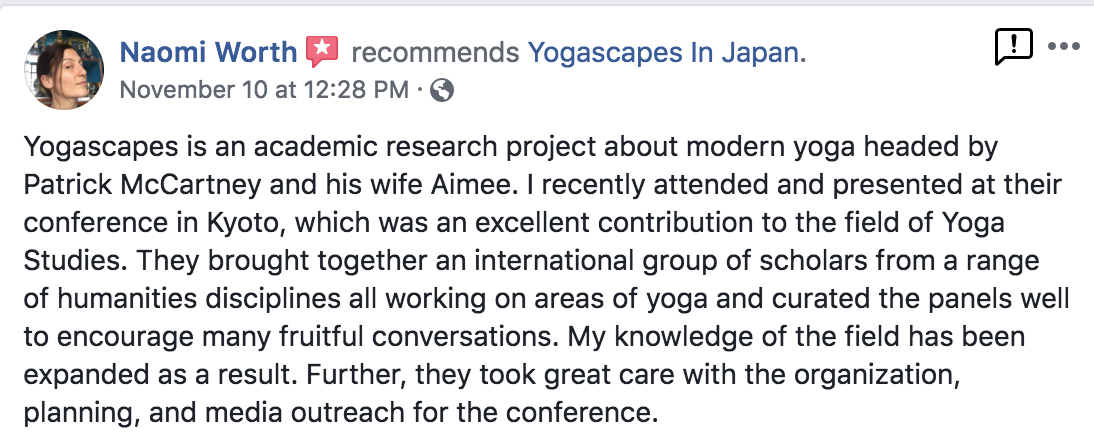Global Yoga coercion-scapes
|
The Political Economy of Imaginative Consumption, Implicated Subjects, Wellness Tourism and Sustainable Development | |||||||
July 11-12
2019
| copy_of_yij_20_-_made_with_postermywall__1_.jpg | |
| File Size: | 612 kb |
| File Type: | jpg |

ALL EVENTS ARE FREE
scan the QR code for LIVE stream link
|
Conference Venue: Yoshida Izumidono Location: West Campus, Kyoto University, Kyoto, Japan #76 on this map |
Charting the biographies of "Yoga" and Sanskrit
Any related topic that explores in a critical and objective way how yoga-inflected lifestyles, both historical and contemporary, philological and anthropological, are imaginatively consumed to generate individual and collective meaning, identity and community can be discussed.
This relates to and includes the subtle intersections and fuzzy social-political-economic boundaries that unite different 'worlds' in unanticipated ways. Ultimately, this conference rests within an emancipatory paradigm that aims to critically examine the complex networks of desire and consumption related to transformational '(self-)development'; not only of the individual, but also the community, nation, and world. This new industry report on the economics of wellness tourism, female consumption and soft power is intriguing. Just how problematic is yoga-focused niche wellness tourism for tourism-reliant economies?
Your browser does not support viewing this document. Click here to download the document.
https://www.iltm.com/RXUK/RXUK_ILTM/2019/Reports/CatchOn_Report.pdf
Can yoga and Sanskrit really make the individual and world a better place? Can yoga and Sanskrit really save the world? If so, how? While these questions might sound ludicrous to the outsider, to the "true believer" these assumptions are central. For instance, Katy Jane, explains through an appeal to mystery, that:
Can yoga and Sanskrit really make the individual and world a better place? Can yoga and Sanskrit really save the world? If so, how? While these questions might sound ludicrous to the outsider, to the "true believer" these assumptions are central. For instance, Katy Jane, explains through an appeal to mystery, that:
Sonic Healing Through Vedic Chanting
There’s a secret behind Vedic chanting as vibrational medicine. [...] As a vibrational language, Sanskrit is not only about translating texts. It’s meant to be heard and repeated. Just hearing the sounds—perfectly intoned—is a powerful therapy for both the individual and society. [...] Varṇa is the proper pronunciation of the Sanskrit syllables. To make each sound correctly requires a precise positioning of the organs of speech in order to direct the prāṇa (life-force) back to the central core of the body. When we speak our ordinary language, we expel our lifeforce and deplete our energy. But when pronounced precisely, chanting the Sanskrit syllables re-directs the prana back into the body, awakening vigor and higher intelligence.
There’s a secret behind Vedic chanting as vibrational medicine. [...] As a vibrational language, Sanskrit is not only about translating texts. It’s meant to be heard and repeated. Just hearing the sounds—perfectly intoned—is a powerful therapy for both the individual and society. [...] Varṇa is the proper pronunciation of the Sanskrit syllables. To make each sound correctly requires a precise positioning of the organs of speech in order to direct the prāṇa (life-force) back to the central core of the body. When we speak our ordinary language, we expel our lifeforce and deplete our energy. But when pronounced precisely, chanting the Sanskrit syllables re-directs the prana back into the body, awakening vigor and higher intelligence.
This next example, from a recent NY Times article, demonstrates how the humanitarian ethic is embedded in the marketing-recruitment strategy of global yoga.
‘You Are Changing Life on the Planet!’
In a companywide email from 2014 obtained by The Times, Heather Peterson, the company’s chief yoga officer, seemingly framed CorePower’s recruitment model as humanitarian. “The impact that yoga practice makes in each person’s life is profound!” the email reads, lauding a teacher who had recruited six people in a single week. “When you multiply that by the impact of being immersed in yoga for 8 weeks in Teacher Training, you are changing life on the planet!”
‘You Are Changing Life on the Planet!’
In a companywide email from 2014 obtained by The Times, Heather Peterson, the company’s chief yoga officer, seemingly framed CorePower’s recruitment model as humanitarian. “The impact that yoga practice makes in each person’s life is profound!” the email reads, lauding a teacher who had recruited six people in a single week. “When you multiply that by the impact of being immersed in yoga for 8 weeks in Teacher Training, you are changing life on the planet!”
One principal aim of this conference is to discuss practicable methodological ways to measure both qualitatively and quantitatively the ambivalent claims used to create demand for the consumption of yoga-inflected lifestyles. And, also, explore some of the potential unintended consequences that might arise through consuming various types of "yoga" attenuated by arbitrary, pseudoscientific and ethno-nationalist claims. As well as the ethical nature of relying on neo-romantic pseudoscientific appeals to mystery and authority. What does this do for the perceived credibility of yoga producers and consumers? Should we care? Why are many yoga-related topics considered by some "true-believing" yoga people to be taboo? Should we dare risk causing offense in the process of working out delicate and difficult issues? Or, are we forever bound by political correctness and perceived levels of authority and legitimacy thrust upon us by self-proclaimed protectors of 'authentic yoga traditions' and their authoritarian identity politics? How to practicably bridge the gap in a meaningful and substantive way between the often anti-intellectual disposition of the yoga 'practitioner' and the objective, distanced gaze of the 'scholar'?
What to make of the marketing spin embedded in the rhetoric of not only the global wellness tourism/yoga industry, but also that of the Indian state? There is a continuum of tacit endorsement through a shared neo-Romantic ethic, neo-Pagan mood and deep-ecological (dharmic) theology that unifies within an utopian aspiration the will to transform the world through yoga. As a soft-power exercise, in 2014, the Prime Minister of India, Narendra Modi, asserted, that:
Yoga is an invaluable gift of ancient Indian tradition. It embodied unity of mind and body; thought and action; restraint and fulfilment; harmony between man and nature and a holistic approach to health and well-being. Yoga is not about exercise but to discover the sense of oneness with ourselves, the world and Nature. By changing our lifestyle and creating consciousness, it can help us to deal with climate change.
Yet, as Jaggi Vasudev explains in this promotional video from IDY 2016, there is very little in the way of any policy beyond the idea that yoga...works...to raise consciousness and this, by itself, will seemingly lead to a more sustainable world.
Both the Indian state (through its Ministry of External Affairs, Ministry for Tourism and AYUSH) and the global wellness industry endorse neoliberal values that coerce us into the consensus-building process of finding a yogic 'way of life' or 'tribe' through consuming yoga-inflected lifestyles so that we can experience the 'transformational' 'power' to one day become super-men and women and assert our position on some arbitrary moral index through "finding our True North."
Yet, if the aim is to increase inbound tourists to countries like India; which ordinarily requires an increase in the global carbon supply chain, what will become of the various types of pollution that an increase in tourism would necessitate? As Dong et al explain, "According to AirVisual, the top 10 polluted cities were dominated by India, Pakistan and China in 2018." However, while it is a hard sell, the Incredible!ndia marketing program has done little to assuage the incredible amount of pollution. Which leads to the $108million-dollar questions: How will Indian state's desire to double the foreign tourist arrivals help reduce pollution? How will performing the Common Yoga Protocol improve the quality of the air? Perhaps, the answers lay in white papers, such as this one, Yoga, Personal Transformation, and Global Sustainability?
Extended
DEADLINE
for submission
25 JUNE 2019
Some positive reviews about the project.

Yogascapes in Japan by Patrick McCartney is licensed under a Creative Commons Attribution-NonCommercial-ShareAlike 4.0 International License.
